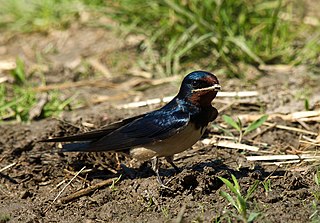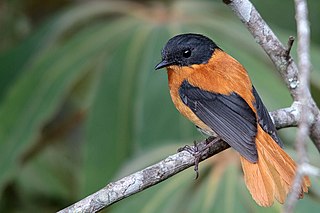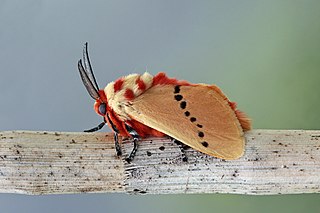Related Research Articles

The bird genus Hirundo is a group of passerines in the family Hirundinidae. The genus name is Latin for a swallow. These are the typical swallows, including the widespread barn swallow. Many of this group have blue backs, red on the face and sometimes the rump or nape, and whitish or rufous underparts. With fifteen species this genus is the largest in its family.

The flannel moths or crinkled flannel moths are a family of insects. They occur in North America and the New World tropics. The larvae are called puss caterpillars, and with their long hairs, resemble cotton balls. They have venomous spines that can cause a painful sting and inflammation lasting for several days. In some cases, the sting may cause headache, nausea, and shock-like symptoms. Perhaps the most notorious for stinging is the caterpillar of Megalopyge opercularis.

The black-and-orange flycatcher or black-and-rufous flycatcher is a species of flycatcher endemic to the central and southern Western Ghats, the Nilgiris and Palni hill ranges in southern India. It is unique among the Ficedula flycatchers in having rufous coloration on its back and prior to molecular studies was suggested to be related to the chats and thrushes.

The black-and-rufous swallow is a species of bird in the family Hirundinidae.

The black-and-rufous warbling finch is a species of bird in the tanager family Thraupidae.

The black-and-tawny seedeater is a species of bird in the family Thraupidae.

Trosia is a genus of moths in the family Megalopygidae described by Jacob Hübner in 1820.
Edebessa is a genus of moths in the family Megalopygidae erected by Francis Walker in 1856.
Norape argyrorrhoea is a moth of the Megalopygidae family. It was described by Jacob Hübner in 1825. It is found in Argentina, Trinidad, Brazil, Guyana, Venezuela, Paraguay, Panama, Costa Rica and Mexico.
Trosia circumcincta is a moth of the Megalopygidae family. It was described by William Schaus in 1905. It is found in French Guiana.

Trosia dimas, the rosy ermine, is a moth in the family Megalopygidae. It is found in Colombia, Venezuela, Ecuador, Brazil, and Peru.
Trosia fallax is a moth of the Megalopygidae family. It was described by Felder in 1874.
Trosia flavida is a moth of the Megalopygidae family. It was described by Paul Dognin in 1911.

Trosia nigropuncta is a moth of the Megalopygidae family. It was described by Druce in 1909.
Trosia ochracea is a moth of the family Megalopygidae, first described by Walter Hopp in 1922. It is found in Brazil.
Trosia pellucida is a moth of the Megalopygidae family. It was described by Heinrich Benno Möschler in 1877. It is found in Brazil and French Guiana.

Trosia nigropunctigera is a moth of the family Megalopygidae. They are distributed across Costa Rica, Panama, Colombia, Venezuela, Guyana, Ecuador and Peru. The species was described by David Stephen Fletcher in 1982.
Trosia rufa is a moth of the family Megalopygidae. It was described by E. Dukinfield Jones in 1912. It is found in Brazil.
Trosia zikani is a moth of the family Megalopygidae. It was described by Walter Hopp in 1922. This moth is found in Brazil.
Trosia acea is a moth of the family Megalopygidae. It was described by Walter Hopp in 1930. It is found in Colombia.
References
- ↑ Flickr
- ↑ Beccaloni, G.; Scoble, M.; Kitching, I.; Simonsen, T.; Robinson, G.; Pitkin, B.; Hine, A.; Lyal, C., eds. (2003). "Trosia nigrorufa". The Global Lepidoptera Names Index . Natural History Museum . Retrieved May 16, 2018.
- ↑ INPN
| This article relating to the superfamily Zygaenoidea is a stub. You can help Wikipedia by expanding it. |